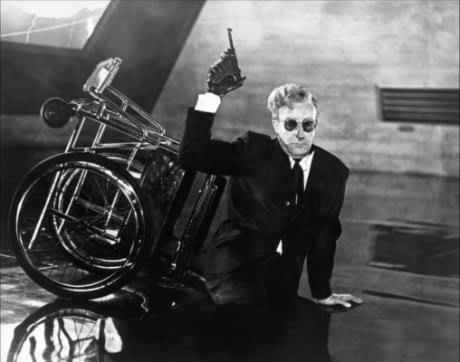When Stanley Kubrick originally started adapting Peter George's novel Red Alert, which was, in part, inspired by and drawn from the writer's own personal experiences in the Royal Air Force during WWII, he intended to make a straight adaptation, outlining the horrific ease in which a nuclear war and, resultantly, the end of the world could come about.
As the adaptation process evolved, and Kubrick speculated about the many ways that this story of a crazed influential General ending the world could play out, the element of aggressive satire was introduced, only without any overt spoof elements to detract from the harsh reality of Cold War paranoia. In such, the sets, shot composition, props and structural elements of the film, right down to plot progression, were played straight, while phallic imagery, bizarre names and candidly framed hyper-realized situations exacerbated the insanity of it all with a sly comic eye.
From the opening scene, where a mid-air plane refueling closely resembles the act of coitus, to the exaggerated protrusion of U.S. Brigadier General Jack Ripper's (Sterling Hayden) cigar phallus in the opening scene, the exaggerated element of male dick-measuring and repressed sexual frustration frequents the visual symbology. As Ripper puffs and sucks on his cigar, he orders Lionel Mandrake (Peter Sellers, in one of three roles) to put the base on alert, thus ordering planes near Russia to attack, enabling a contingency plan that blocks out external communications, leaving everyone on the ground unable to stop the impending nuclear war.
With a woman in high heels and underwear relaying apocalyptic information to General Turgidson (George C. Scott) while he goes to the bathroom, and the president, Merkin Muffley (Sellers), having casual touchy-feely conversation with the Soviet premier when advising him of the accidental attack, the satirical comic element shifts into high gear.
The story vacillates between bumbling War Room conversation with American officials and the carefree manner in which those in the sky handle dropping nuclear bombs on Russia—reading porn magazines and smoking cigars—showing an abundance of immaturity and disorganization amidst men of global significance discussing the logistics of a doomsday device intended to destroy humanity. Amidst these storylines that occasionally channel Nazi ideology, General Ripper rambles on to Mandrake about the Russians using a fluoridation process to pollute American waters and ultimately their male "essence."
The hilarity of it all stems not only from the discomforting political realities of the time, wherein such a scenario wasn't particularly far-fetched, but also from the counter-intuitive critique of male posturing. Nuclear arms are paralleled with phallic imagery and discussions of precious bodily fluids suggest sexual frustration—or blue balls—as impetus behind male destruction.
Amusingly, the implication here is that frequent ejaculation could possibly save the world.
Dr. Strangelove or: How I Learned to Stop Worrying and Love the Bomb screens at the TIFF Bell Lightbox as part of the Countdown to Armageddon screening series at 6:30pm on December 14th, 2012.
(Columbia)As the adaptation process evolved, and Kubrick speculated about the many ways that this story of a crazed influential General ending the world could play out, the element of aggressive satire was introduced, only without any overt spoof elements to detract from the harsh reality of Cold War paranoia. In such, the sets, shot composition, props and structural elements of the film, right down to plot progression, were played straight, while phallic imagery, bizarre names and candidly framed hyper-realized situations exacerbated the insanity of it all with a sly comic eye.
From the opening scene, where a mid-air plane refueling closely resembles the act of coitus, to the exaggerated protrusion of U.S. Brigadier General Jack Ripper's (Sterling Hayden) cigar phallus in the opening scene, the exaggerated element of male dick-measuring and repressed sexual frustration frequents the visual symbology. As Ripper puffs and sucks on his cigar, he orders Lionel Mandrake (Peter Sellers, in one of three roles) to put the base on alert, thus ordering planes near Russia to attack, enabling a contingency plan that blocks out external communications, leaving everyone on the ground unable to stop the impending nuclear war.
With a woman in high heels and underwear relaying apocalyptic information to General Turgidson (George C. Scott) while he goes to the bathroom, and the president, Merkin Muffley (Sellers), having casual touchy-feely conversation with the Soviet premier when advising him of the accidental attack, the satirical comic element shifts into high gear.
The story vacillates between bumbling War Room conversation with American officials and the carefree manner in which those in the sky handle dropping nuclear bombs on Russia—reading porn magazines and smoking cigars—showing an abundance of immaturity and disorganization amidst men of global significance discussing the logistics of a doomsday device intended to destroy humanity. Amidst these storylines that occasionally channel Nazi ideology, General Ripper rambles on to Mandrake about the Russians using a fluoridation process to pollute American waters and ultimately their male "essence."
The hilarity of it all stems not only from the discomforting political realities of the time, wherein such a scenario wasn't particularly far-fetched, but also from the counter-intuitive critique of male posturing. Nuclear arms are paralleled with phallic imagery and discussions of precious bodily fluids suggest sexual frustration—or blue balls—as impetus behind male destruction.
Amusingly, the implication here is that frequent ejaculation could possibly save the world.
Dr. Strangelove or: How I Learned to Stop Worrying and Love the Bomb screens at the TIFF Bell Lightbox as part of the Countdown to Armageddon screening series at 6:30pm on December 14th, 2012.




